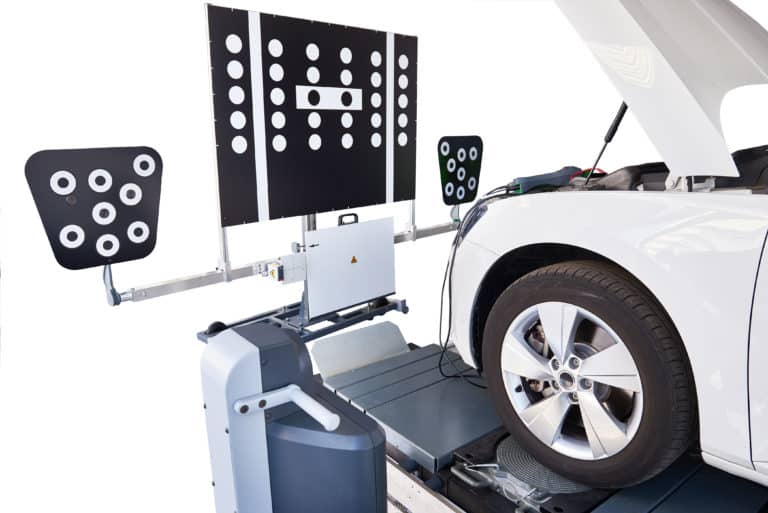Are you curious about Honda’s advanced driver-assistance systems (ADAS) package, known as Honda Sensing? ADAS technology is a hot topic in the automotive world right now, and for a good reason—ADAS can make driving safer and more enjoyable. This article has all you need to know about Honda ADAS.
What is Honda Sensing?
Honda Sensing is the name for Honda’s ADAS (advanced driver assistance systems) safety and driver assistive package that helps prevent crashes or lessen their severity, with the potential to also reduce driver fatigue. This ADAS system is a collection of vehicle information and control systems that use data from advanced sensors—including ultrasonic, radar, camera, (and LiDAR soon)—to provide drivers with information and warnings while driving. In some cases, ADAS can even assist with a vehicle’s steering and/or braking to avoid or lessen the effects of a collision or potential road departure.
Honda ADAS Sensors
The initial Honda Sensing system employed cutting-edge “sensor fusion” technology, which joined the sensing capabilities of a millimeter-wave radar mounted behind the grille, and a windshield-mounted ADAS camera. Since that time, certain newer models like the 11th-generation Civic included a faster processor and an updated sensor setup. Where previous Honda ADAS systems had a radar-camera combo, a new single-camera system provides a broader detection area. The new camera and processor technology (and updated software) allow for faster and more accurate recognition of pedestrians, bikes, and other vehicles, as well as road lines and street signs.
Honda Sensing: Honda ADAS Features
Honda Sensing is broken up into several different ADAS features with specific capabilities, also known as “safety and assistance features” in Honda’s literature. Each of these Honda ADAS features is designed to help drivers in a specific way during certain circumstances.
The Honda Sensing ADAS package has evolved to include more features and more advanced systems since it first came out. In general, most cars with Honda Sensing have these features:
- Collision Mitigation Braking System (CMBS) — This uses a camera and radar sensor to detect potential collisions and apply the brakes if necessary. This feature is unique to Honda Sensing and incorporates features of Forward Collision Warning (FCW) system and Automatic Emergency Braking, including Pedestrian AEB.
- Road Departure Mitigation System (RDM) — This ADAS system uses a camera to detect lane markings and provides warnings and, depending on the model, mild steering and/or braking adjustments if you cross them. Depending on the model, it can provide light steering input and braking to reduce the chance of road departure, but it does not take over steering. If a driver takes no action, the vehicle could still ultimately drive off of the road depending on the specific circumstances.
- Adaptive Cruise Control (ACC) — This system uses a radar sensor and/or camera sensor to maintain a set following distance from the car in front of you. Low-Speed Follow is included on some models.
- Lane Keeping Assist System (LKAS) — This system uses a camera to detect lane markings and help keep the car centered in its lane.
- Traffic Sign Recognition (TSR) — This system uses a camera to detect and recognize traffic signs. Information is relayed to the diver.
- Lane Departure Warning (LDW) – This system uses the windshield-mounted camera to detect lane lines, and when the driver starts drifting out of the lane without signaling, he or she is alerted.
- LaneWatch – Previously, but no longer available, this system is an earlier version of blind-spot monitoring, on the passenger side only, using a rear-mounted camera beneath the passenger side mirror to display the area when the right turning signal is activated.
- In addition, a snapshot of the Honda Sensing offerings also includes two features available on some Honda models:
- Traffic Jam Assist (TJA) — When both ACC and LKAS are enabled, TJA provides light steering assist, but can also bring the vehicle to a complete stop when lane markers are detected and there is a vehicle detected ahead of you. At less than 45 mph, it helps drivers maintain lane position, such as during a traffic jam with stop-and-go traffic.
- Driver Attention Monitor – Input from the Electric Power Steering measures driver attentiveness. When attention is waning, warnings are provided to the driver visually first, but then with audible and a rumble.
Additional Honda ADAS Features
Honda offers three additional ADAS systems, referred to as driver-assistive technology features, on some models. These limited-availability options include the following:
- Blind Spot Information System — This system uses sensors to detect vehicles in your blind spot and alerts you with a warning light on the corresponding mirror.
- Cross Traffic Monitor — When the vehicle is in reverse, with the multi-angle rearview camera in any viewing mode, the driver is alerted to a detected vehicle approaching from the side with a series of beeps and indicators shown on the screen.
- Auto High-Beam Headlights — This system uses a camera to detect oncoming traffic and automatically switches between high and low beams.
Honda’s ADAS History
While ADAS is a relatively new technology, it has come a long way in a short time. The same holds true for Honda Sensing. Below is a brief overview of some of Honda’s most significant ADAS milestones.
- 2003 – Honda develops the world’s first automatic emergency braking (AEB) system, named the Collision Mitigation Brake System (CMBS).
- 2006 – Honda introduces the CMBS in the Acura RL as the industry’s first production vehicle with available AEB.
- 2012 (September) – American Honda starts selling 8th generation Accord with LDW, FCW, and LaneWatch.
- 2012 (April) – American Honda announces new visibility technologies, including rearview cameras, to be applied to more than 97 percent of all 2013 U.S. Honda models, along with an Expanded View Driver’s Mirror and LaneWatch blind-spot display, which uses a camera in the passenger-side mirror to show an expanded view of the road when the turn signal is activated
- In 2014 – Honda Sensing was introduced on the 2015 Honda CR-V Touring trim.
- 2015 (September) – 10th generation 2016 Civic Sedan, the first model to make Honda Sensing available on all trims.
- 2015 (July) – The 2016 Accord included Honda Sensing.
- 2018 (April) – More than one million cars on U.S. roads with Honda Sensing – Honda 2021 Digital FactBook.
- 2018 – the redesigned 2018 Accord includes traffic sign recognition and road departure mitigation.
- 2019 – LaneWatch begins phase out. Instead of the LaneWatch camera-based display system, future vehicles have blind spot monitoring systems that utilize rear radar sensors.
- 2021 (March) – Honda launches the first production SAE Level 3 automated driving car in Japan, making it the first production car to qualify as Level 3 on SAE’s automated driving levels.
- 2021 (April) – Honda announces the new 2022 11th generation Civic with a new wide-view front ADAS camera instead of the previous radar-and-camera system. The new release also adds Traffic Jam Assist and Low-Speed Braking Control (Touring), includes ACC and LKAS improvements and has eight sonar sensors for low-speed braking control and false-start prevention (front and rear).
- 2022 — LaneWatch ends.
- 2023 – Honda Sensing is now standard on all new Honda passenger vehicles in the United States.
Honda’s ADAS Future
Honda has future goals to reduce automobile and motorcycle fatalities involving Honda products to zero. As part of their zero-fatalities goal, Honda has several technology plans in the works, including:
- SAE Level 3 autonomous driving capability, also known as highly automated freeway driving, was released by Honda in Japan, but hasn’t made its way to U.S. production vehicles yet.
- Honda Sensing 360, the brand’s next generation of ADAS, is slated for all newly released automobiles in major markets by 2030. Honda calls this technology “omnidirectional ADAS” and “the world’s first artificial intelligence (AI)-powered ‘Intelligent Driver-Assistive Technology.’” It uses AI to detect driving risks, determine optimal driving behavior in real-time, and assists drivers based on their cognitive state and the traffic situation.
In addition to these three specific ADAS programs, Honda is researching and developing several other ADAS-related projects, including better motorcycle detection, road condition monitoring, and Safe and Sound Network technology.
At Car ADAS, we are dedicated to protecting lives through the precise calibration of Honda Sensing, as well as other vehicle safety systems. Help us protect lives by scheduling an ADAS calibration appointment at our calibration facility in Salt Lake City, Utah, or learn more about opening your own calibration center today!
Read More: Getting Started in the ADAS Business
Note: Car ADAS Solutions always recommends checking the OEM repair procedures before working on any vehicle.
Related Articles:







